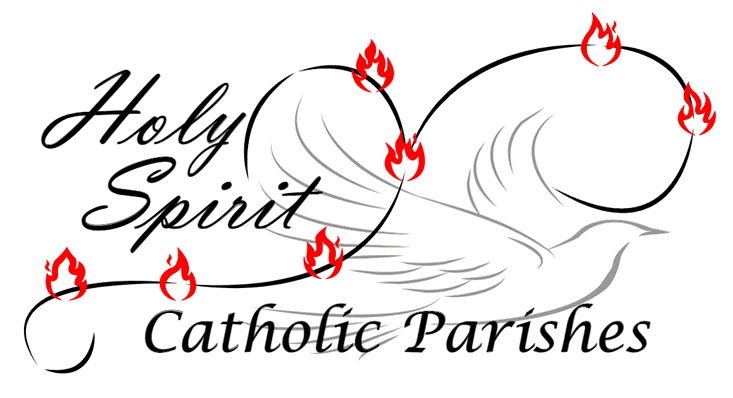History
History of St. Peter, Newcastle, Nebraska
Immigration
Immigration to the United States and Nebraska brought people from foreign countries, mainly Ireland and Germany. Immigrants longed for a better life due to hardships in their homelands, famine, religious beliefs and governmental controls, and seeking opportunities to own farm land. Others were interested in adventure.
Motives for immigration were also based on geological conditions of stony soil, which had to be worked six days a week for a meager income. Also, a few continuous years of hail storms, droughts, crop failures, and insect invasions resulted in loss of crops to sell for income and food. Some crops were used for crafts, including spinning silk, which also led to loss of jobs and loss of income.
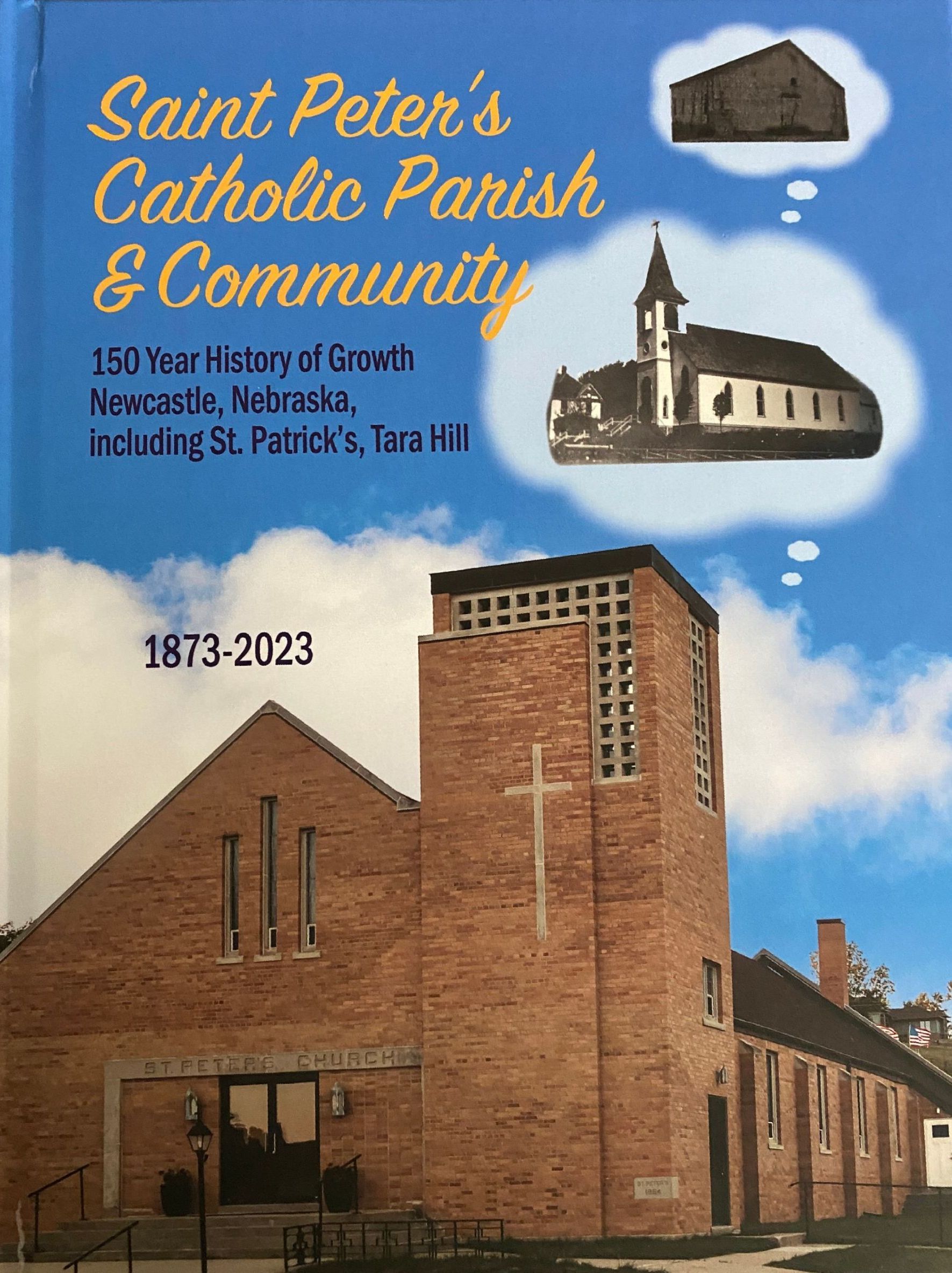
History excerpts from Saint Peter's Catholic Parish & Community: 150 Year History of Growth, Newcastle, Nebraska, p. 16-29.
Property was divided in different ways. With some families, property was divided among heirs of several children in the family, resulting with small acreages that did not provide enough income to live. In other families, property was given to the oldest child and left nothing to finance the younger children. Division of property also led to social implications for the smaller families of one or two children who then were wealthy.
The poorer citizens were forced to write a petition to a local community to ask for public funds for support: getting seed for a mercy price and the option for an inexpensive loan. A day laborer earned less than what a loaf of bread cost. Industrialization also caused a decline of textile trade with people losing jobs.
During 1841 to 1860, most immigrants came from Great Britain, Germany, and especially Ireland.
The Irish Potato Famine, also known as the Great Hunger, began in 1845, when a mold known as Phytophthora infestans (or P. Infestans) caused a destructive plant disease that spread rapidly throughout Ireland. The infestation ruined up to one-half of the potato crop that year, and about three-quarters of the crop over the next seven years. Because the tenant farmers of Ireland, then ruled as a colony of Great Britain, relied heavily on the potato as a source of food, the infestation had a catastrophic impact on Ireland and its population. Before it ended in 1852, the Potato Famine resulted in the death of roughly one million Irish from starvation and related causes, with at least another million forced to leave their homeland as refugees.
In 1848, the French Revolution started in Germany, spreading across Europe with large demonstrations for increased political freedom. The Revolution failed and immigrants were known as the Forty-Eighters. Some families had a governmental support granted, but could not afford the passage. Towns were known to pay the passage to America for disagreeable citizens and poor families to avoid the family of depleting the municipality funds. Other families sold their property and paid their way to America when hearing about the increased technology in America.
Immigrants, who traveled to Nebraska, found the soil to be fertile, appealing for farming and inexpensive. They wrote letters back home to encourage family and friends to migrate to Nebraska. In the 1850's and 1860's, Nebraskans came by steamboat via the Missouri River and by covered wagon from the east. In 1854, an all time high of 215,000 Germans arrived in America. Many immigrated to the mid-west to buy farms. In 1864, Irish immigrants coming to Nebraska cities stayed to work on railroads while others took jobs as laborers. The railroads were an influence to settlers as they built communities in and near the depots, which were considered to be the hubs where home, farm, industrial supplies, and materials were delivered by train.
Letter to the "London Times" from an Irish Immigrant in America, 1850
"I am exceedingly well pleased at coming to this land of plenty. On arrival, I purchased 120 acres of land at $5 an acre. You must bear in mind that I have purchased the land out, and it is to me and mine an "estate for ever", without a landlord, an agent or tax-gatherer to trouble me. I would advise all my friends to quit Ireland---the country most dear to me; as long as they remain in it, they will be in bondage and misery.
What you labor for is sweetened by contentment and happiness; there is no failure in the potato crop, and you can grow every crop you wish, without manuring the land during life. You need not mind feeding pigs, but let them into the woods and they will feed themselves, until you want to make bacon of them.
I shudder when I think that starvation prevails to such an extent in poor Ireland. After supplying the entire population of America, there would still be as much corn and provisions left us would supply the world, for there is no limit to cultivation or end to land. Here the meanest labourer has beef and mutton, with bread, bacon, tea, coffee, sugar and even pies, the whole year round---every day here is as good as Christmas day in Ireland."
Immigration to the United States and Nebraska---appealing
Immigration to the United States and Nebraska from foreign countries was made appealing with the offering to claim free land by the Federal Government. On May 20, 1862, the Federal Government introduced the Homestead Act, which granted 160 acres of surveyed public land for five years of residency, and cultivation on the land for a small filing fee. This was done to increase the settlement of the western territory. Few laborers and farmers could afford to build a farm or acquire the necessary tools, seed, and livestock. Therefore, in Nebraska at that time, most of those who purchased land under the Act came from Iowa. Those in foreign countries were drawn to relocate due to the Homestead Act. Farmers claimed their land. The farmers brought tools. Most of their farm tools, they made, including flails, harrows and rakes. Pitchforks were made by attaching long handles to deer antlers. They cleared their land using an ax to cut away brush, chop down trees, and trim logs. Stumps and rocks were removed. Oxen and horses pulled plows and did the heavy work.
In the 1860's, travel was made easier for immigrants. Steam ships reduced the length of time from 12 and 16 weeks to 7 and 10 days to cross the Atlantic. Passage was safer with lighting in the hatchways, ventilation, and warmed by steam. With growing shipping companies, fares decreased making immigration more economical.
Communities grew as immigrants from foreign countries continued to come to Nebraska, seeking economic opportunities. In 1860, the population of Nebraska was about 30,000. The population in 1920 had increased to approximately 1,296,000.
In The Very Beginning
In the early years, before St. Peter's Catholic Church at Newcastle, Nebraska was established, immigrants came from foreign countries to America hoping for a better life from what they were experiencing in their homelands. The first immigrants coming to what is now the Newcastle area were mostly from Germany, Ireland, Wisconsin, Illinois, Iowa, and South Dakota.
Due to the open prairies, where very few trees grew, many farm homes of the first settlers were dugouts and sod huts. Later with tree seedling having been planted and developed, log homes were built. Saw mills were built, transportation modes also improved and lumber was hauled to requested locations.
William Pfister, who came from Harden County, Iowa in 1858, was one of the first Catholics to settle within the boundary lines of the Newcastle parish. He lived in a sod hut. He anticipated finding an unsettled country and found he had Native Americans for neighbors. He made friends with his neighbors and through the years his most frequent visitors were Native Americans passing through on their way between the Omaha and Santee agencies.
Listen to the history of St. John City, founded by Fr. Jeremiah Trecy, as part of Fr. Vogel's Faith on the Frontier series.
Churches had not yet been established; however, through the years of 1858 – 1877, traveling Catholic priests would pass through the area at rare intervals to offer a Mass, stopping at the few and far between homes as they happened upon them. William Pfister welcomed and invited the traveling priests to stay with him for the weekend. Father Jeremiah Trecy, a young Priest from the Garyowen Parish near Dubuque, Iowa, who founded the Jackson Colony in 1856, was a traveling priest who would stop in this area. In 1858, the successor of Father Trecy was Father Jillion who officiated at the first known mass that was offered in the Mission of Newcastle in William Pfister's sod hut. For the next nineteen years, Catholics in the area were visited by traveling priests, Father Doescher, Father Michael P. Waldron, and Father Michael O'Toole. Bishop James Michael Myles O'Gorman stopped in Newcastle on several occasions to say mass for the Catholic families in the community.
In 1873, the first church of St. Peter's Catholic Church was built in the Village of Newcastle. Its dimension was 24' x 36'. For several years, the interior of the church was left unfinished. The church had a cottonwood floor and was without any paint or plaster. The altar consisted of a cottonwood board. Martin and Phillip Kneifl came from Baden, Austria, to look for farmland, settling near Newcastle. Being devout Catholics, they helped build the first Catholic Church in Newcastle. Phillip often led the singing at Mass. Several years later, Father O'Toole finished the interior of the church and built a residence.
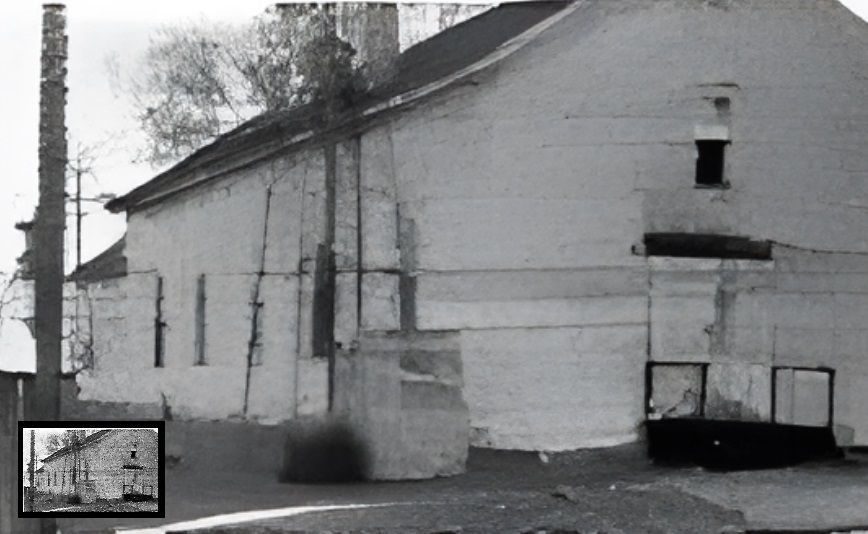
First St. Peter church built in 1873. This is an AI enhanced image based on the original in the lower left corner.
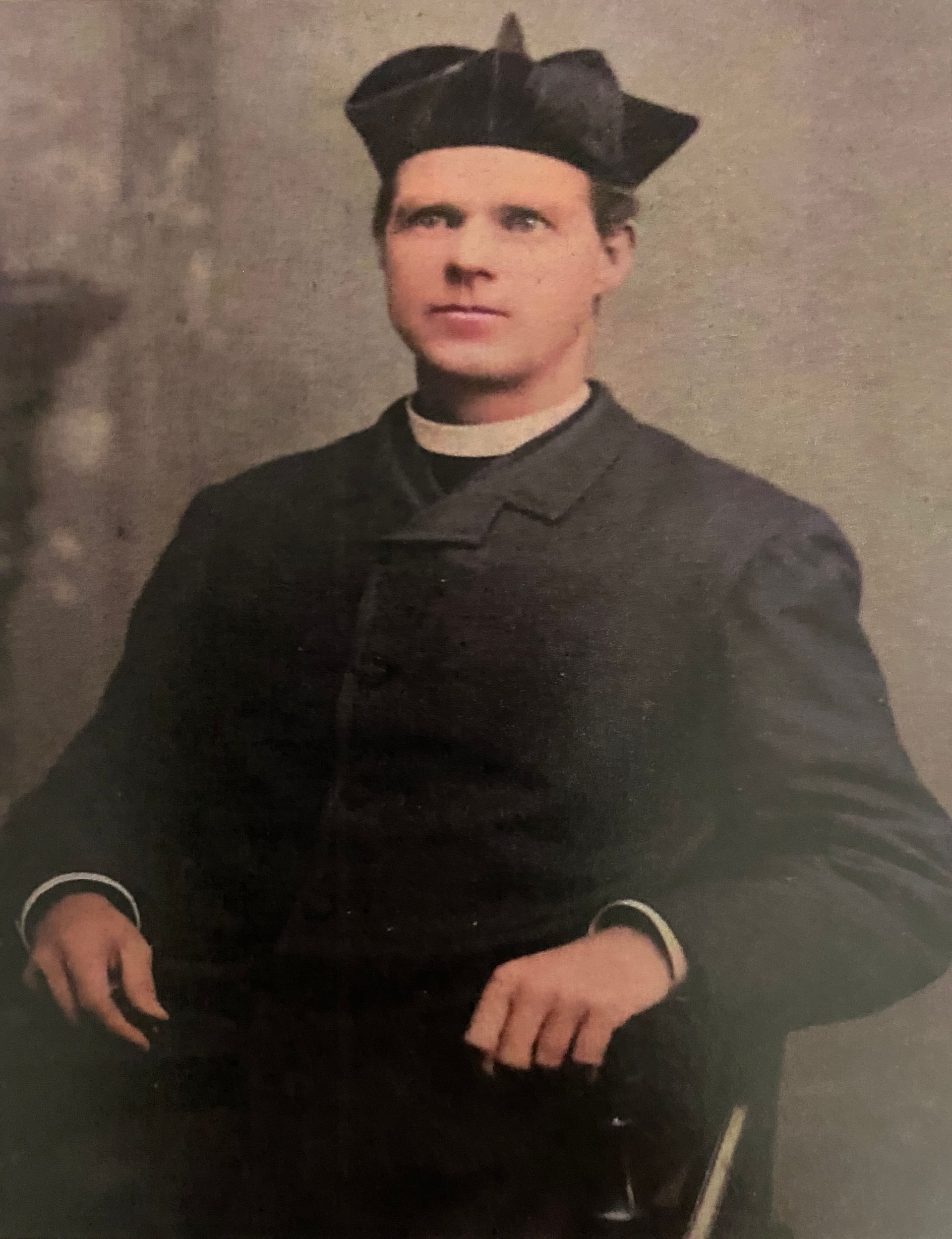
Fr. Michael O'Toole
Father Michael O'Toole was born in County Mayo in Ireland in the fall of 1849. He came to America in 1863. Upon completion of his theological studies and ordination in Pennsylvania, he came to Newcastle in 1877 and found there to be approximately forty families in the parish, poor and struggling. By 1908, within the same area, the number was approximately eighty families nearly all living in comfortable frame dwellings, which succeeded the dugout. In 1877, Father O'Toole became the first resident pastor of St. Peter's Church. With a resident pastor, St. Peter's was no longer a Mission, it was now a Parish. Father O'Toole was given the responsibility to oversee all of the 500 square miles of Dixon County, including parts of Dakota and Cedar counties.
The second church of the two churches in Dixon County was located at South Creek approximately four miles south west of Ponca. St. Paul's Catholic Church at South Creek, built in 1875, was a Mission Church to St. Peter's Church and about the same size. Father O'Toole held services at St. Paul's on alternate Sundays for many years. At Christmas and Easter, he felt it his duty to serve at both churches if at all possible. When St. Paul's church received a resident pastor, making it a parish, it combined with Ponca and was separated from Newcastle. Father O'Toole continued serving at St. Peter's Church and returned to serving St. Patrick's Church at Tara Hill.
Listen to the history of St. Paul, South Creek, as part of Fr. Vogel's Faith on the Frontier series.
The first weddings recorded in St. Peter's Church are William Hillen and Anne Crime, 10-2-1877; Michael O'Connor and Anne Donahue, 11-5-1877; and John Engle and Mary Anne Hillen, 11-22-1877.
Previous articles have been written stating Gustavus Smith, a resident of Newcastle since 1856, donated land in Newcastle for the first Catholic Church built in 1873.
We are finding that Gustavus Smith did donate land to the church for a few years. To clarify, while visiting the Omaha Archdiocese, Omaha, Nebraska, in search of historical articles and records for this history book, Warranty Deeds were found for all of St. Peter's Church property, which includes the church, rectory, hall, parking lot and cemetery. The parking lot property is west of the hall and extends to within a few feet of the Newcastle School building. The school requested the use of a portion of the land to build a cemented play area adjoining the east side of the school and to have a school parking lot for students. A lease was signed allowing the school to use the requested land from the church for a certain number of years.
All of St. Peter's property was sold from various land-owners to the Rt. Rev. James O'Connor and the Diocese of Omaha. The Warranty Deeds were all recorded with the Diocese of Omaha at the Diocese of Cheyenne, Wyoming, which included all of Wyoming and Nebraska at that time. The recording of them has since been transferred to the Archdiocese of Omaha at Omaha, Nebraska. The Deeds and Quit Claim Deed have also been recorded at the Dixon County Courthouse in Ponca, Nebraska.
Please see the Section of this book on the explanations and pictures of the deeds to follow up on this.
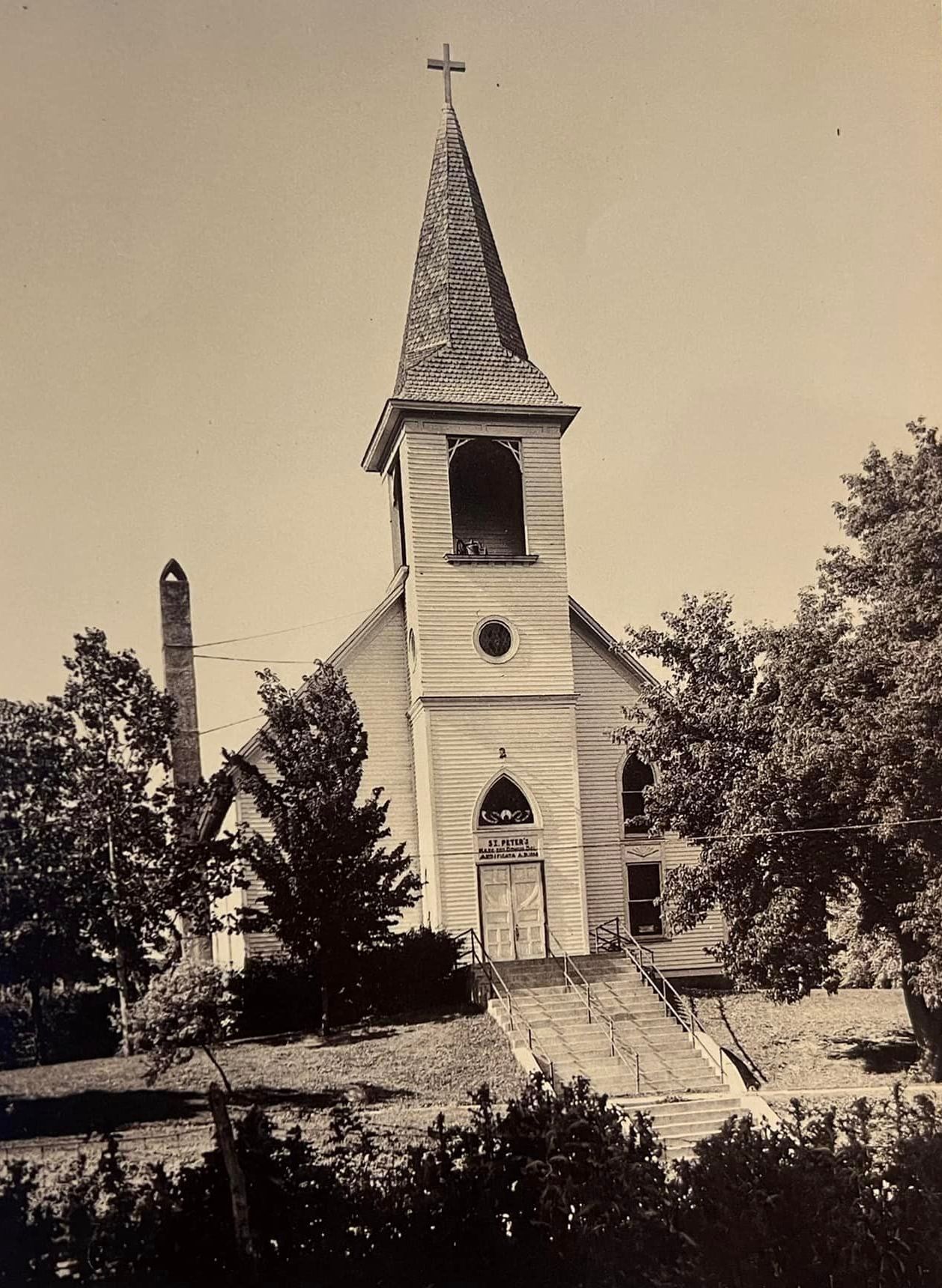
St. Peter's second church, built in 1898.
By 1898, the number of parish families had grown to fifty. Under the leadership of Rev. O'Toole, a new church was built. At this time, this would be the second of three churches for St. Peter's. It was a 40' x 97' structure costing $4,500 and was completely paid for when finished. The first church built in 1873, was then used as the parish hall. A new residence was built in 1901 at a cost of $2,711.00.
The three marriages during this time of closing the old church and opening the new church were: John McCluskey and Mary O'Toole, August 25, 1897; Robert Ross and Florence Taylor, January 25, 1898; and Elmer Gibbs and Mary Ellen Malone, October 12, 1898.
After forty years of faithful service, Father O'Toole retired from active duty in 1919. The Women Foresters gave Father O'Toole a reception and banquet at St. Peter's Hall with 500 persons in attendance. Mr. Verzani presented Father O'Toole with a draft of $1,256.00 and the Woman Foresters bestowed him a silk umbrella. All attended the Opera House for entertainment following the reception.
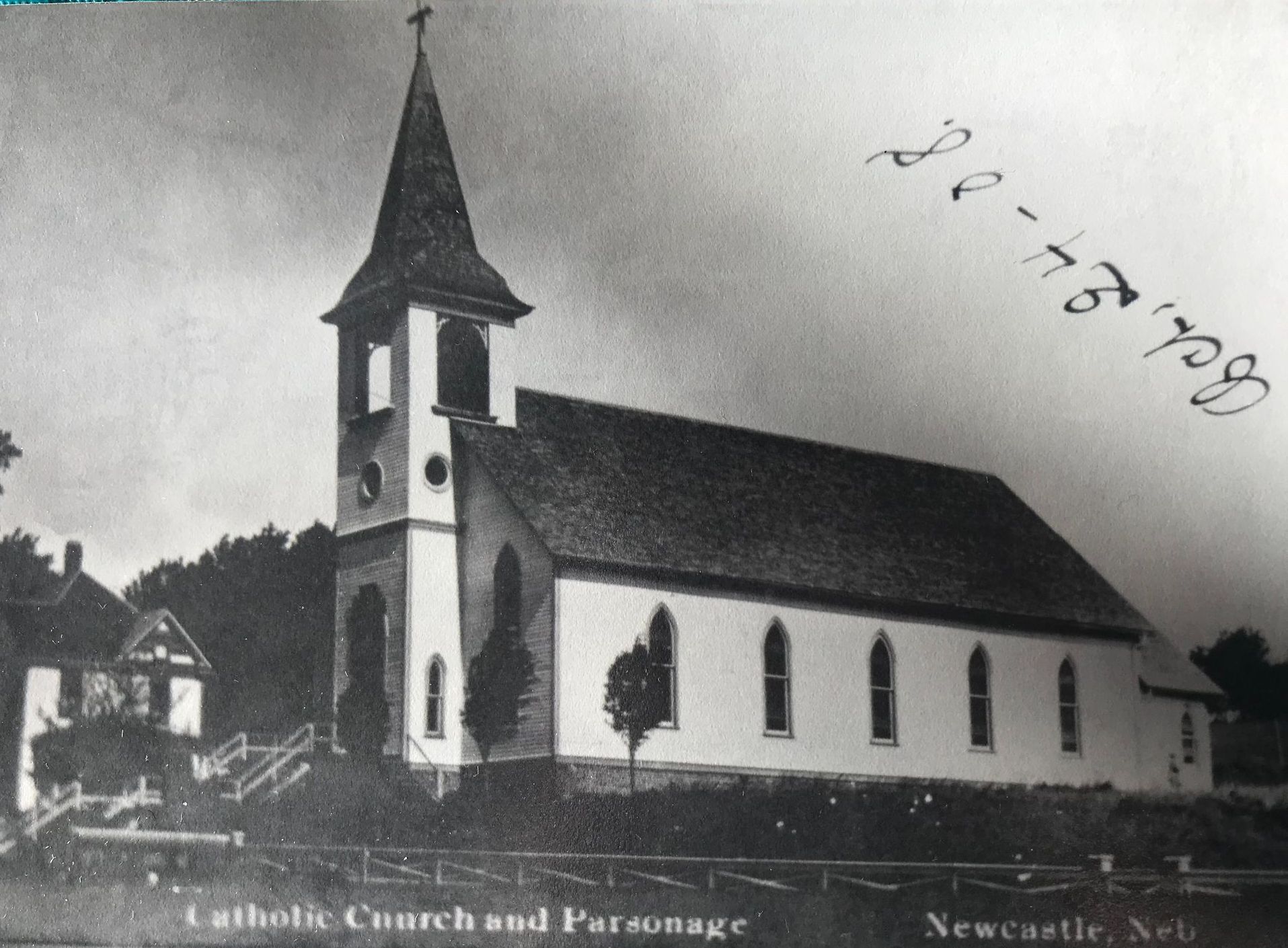
St. Peter's second church, built in 1898. Photo taken in 1908.
Replacing Rev. O'Toole was Rev. William Giblin, who came to Newcastle in 1919 from St. Mary's Parish in O'Neill, Nebraska. In 1920, St. Peter's began First Communion Classes under the guidance of Father Giblin. The class received their First Communion on May 23, 1920, which consisted of 18 boys and 16 girls.
In 1927, Father Giblin was honored on his 10th Anniversary as a pastor in Newcastle with a dinner and program at St. Peter's Hall. The program consisted of Frank Kroger, as Master of Ceremonies, an address by Mrs. A. Lubben, readings by Lucille Breslin, Frances Richards, Mrs. Leo Hoy, solos by Elaine Kent, Esther Bennett and Marie Hoy and a quartet featuring Bernard Koch, Nick Kneifl, and C. Conway.
Realizing the need for improvement of the present structure, Fr. Giblin began the arduous task of collecting funds for improving the old structure in 1945. After much deliberation, it was decided the cost of repairing the old church would be prohibitive and the parish decided to abandon the idea in favor of the erection of a new church.
Father Giblin began working on the plans to construct the new church. However, before the building was actually started, he was transferred to St. Agnes Church in Omaha. The transfer ended 34 years of service as pastorate in Newcastle. A farewell celebration was held in his honor where he was presented with a gift of a car.
In June 1954, Msgr. Albert Krejci became the new pastor of St. Peter's parish, after being transferred from Lyons, Nebraska. Msgr. Krejci continued the movement for a new church. Contributions for the new church totaled $30,000 in his first year, despite a policy of no solicitation. After lots of hard work and planning with the trustees (Louis Reinert and Peter Kneifl), contracts were signed to begin the new church on July 14, 1954.

St. Peter's current church, dedicated in 1955.
To make room for the new church, the original 1873 church, which was being used as the Parish Hall, was moved to Newcastle's main street. It was located north of the current fire hall where it was used as the town hall. (The altar area had been converted to a kitchen, while the nave of the church was used as a hall). In 1972, the building was torn down after 100 years of use.
On May 4, 1955, The Most Reverend Gerald T. Bergan, Archbishop, officiated the pontifical blessing of the new church. The Sioux City architectural firm of William Beutler designed the modern modified Gothic design structure.
William Beutler (9-1883) (6-2-1963) was born in Hannibal, Missouri and was educated at Dixon College in Dixon, Illinois, receiving his architectural training at Washington University in St. Louis, Missouri, in 1910. Hoesing Brother's Construction Company of Hartington, Nebraska, now known as Radac Construction, hired his firm.
Stressing practicality, the structure features simple and modern lines. Overall length is 105 feet with a maximum width of 53 feet. The nave of the church is 40 feet wide by 73 feet long with a seating capacity of 320. A choir loft that can accommodate 40 people is located on the south end of the church. Glass doors feature the main entrance on the south. The large sanctuary is flanked by a priest's sacristy and a server's sacristy on either side. The basement facilitates rest rooms, a utility room and furnace room. In November 1957, the parish celebrated the new church becoming debt free. Today, a handicap restroom has been added off to the west end of the vestibule.
Rectory
A beautiful 3-bedroom, one story rectory with full basement was constructed in 1959. To make room for the rectory, St. Peter's second church building, which was being used as the parish hall, was torn down. Msgr. Krejci, thus became the first person to live in the new rectory. He continued to serve the Newcastle parish until his transfer to Holy Angels Church in Omaha on June 17, 1965.
Leonard's Altar
The second Vatican counsel met from 1962-1965, calling for changes in the mass. Latin was changed to English and the priest would be facing the congregation. Fr. Krejci was a regular guest at the home of Pete and Elizabeth for meals or special occasions. Seeing the cupboards, their son, Leonard, had built in the newly remodeled kitchen, he asked Leonard to build an altar that would be needed in the church when the changes came about. Leonard felt privileged to be able to build the altar, which he did in the farmhouse basement. It was completed and waiting for the time when Fr. Conley would need it.
In 1965, The Rev. Martin Conley became the fifth pastor to serve St. Peter's parish, following tenures at St. Cecilia and St. Bernard's in Omaha. During the winter of 1965-66, a change in the church mass, which would have the priest facing the parishioners, was fast approaching. Now needing an altar, Father Conley asked Leonard Kneifl if the altar was completed and ready for the church. The altar was the centerpiece of the sanctuary for many years.

Free-standing altar build by Leonard Kneifl 1966.
St. Peter's Hall
Father Conley soon saw the need for a new hall for the many social functions of the parish and a place for catechetical classes. He began working on the project the following year. On June 15, 1969, The Most Rev. Gerald T. Bergan, Archbishop of Omaha blessed and dedicated the 4,000 square foot St. Peter's Hall. The Archbishop complimented Father Conley for his work and good taste in the building of this nice hall. He also praised the people and thanked them for their cooperation during past years when these three brick buildings were created.
Starting the Second Century and beyond
Pastoral service during St. Peter's second century has greatly contrasted the first 100 years. After having just six priests in the first 100 years, St. Peter's has already been served by 13 different pastors in the past 25 years, including a second tenure by Msgr. Krejci.
On June 15, 1972, Father Conley was transferred to St. Patrick's Parish in O'Neill. He was replaced by Msgr. Floyd Fischer, who was pastor of St. Joseph's Parish in Platte Center, Nebraska. On June 6, 1973, St. Peter's celebrated its 100 year anniversary with a mass officiated by Archbishop Daniel E. Sheehan. Many former St. Peter's parishioners and pastors were in attendance at the ceremony.
Reverend Gerald Millenkamp succeeded Msgr. Fischer on November 8, 1973. However, just one week after his arrival, tragedy touched St. Peter's Parish as Reverend Millenkamp was killed in a two-vehicle collision, eight miles south of Pender, Nebraska. Many people attended his funeral services at St. Cecilia's Cathedral in Omaha. A Mass kit was donated as a Memorial.
Father Anthony Tresnak was then appointed administrator of St. Peter's until Father William Rucker was appointed pastor of St. Peter's in 1974. After Father Rucker left St. Peter's in 1976, Rev. Daniel F. Soltys was appointed as administrator until Rev. James V. Brown replaced him as a transition substitute in 1978. After having six priests in six years, stability was once again restored at St. Peter's Parish as Msgr. Krejci returned after a 13-year absence. Msgr. Krejci served from 1978 until 1985, when he returned to Omaha. In June of 1981, a celebration was held in honor of Msgr. Krejci's 40th Anniversary.
Father James Kramper came to Newcastle in June, 1985. David Koch, son of Jerry and Carol Koch, then Riley Lowe, son of John and Reno Lowe, were the first two baptisms that he held as a Pastor. Father Kramper served as Pastor at St. Peter's until 1990, when he was succeeded by Rev. Ralph A. Lammers, who remained at Newcastle until 1991. Rev. Ralph Lammers began a Liturgy Committee of several volunteered ladies of the Parish. He appointed Carol Koch as Chairman of it. They met monthly in basement of the Rectory. Many good ideas came from this committee and were approved and implemented. Beautiful banners draped the Altar, hung on poles, and on the choir loft wall, depicting the various Liturgical Seasons of the Church Year. He often visited the homes of the parishioners and loved playing games with the children. Father Lammers was re-assigned in 1991.
Rev. Robert Irwin was then appointed administrator of St. Peter's until Father Frank Jindra came to Newcastle in 1992 and 1993. Father Jindra was succeeded by Rev. Rick Arkfeld, who served at Newcastle from 1993 to 1996. It was during this time that St. Peter's officially began a yoke arrangement with St. Joseph's Parish in Ponca.
In anticipation of the arrival of Rev. James J. Bartak in 1996, the rectory received a complete remodeling as well as a new roof. Father Bartak eventually left St. Peter's and the priesthood, residing in Maryland.
Father David Liewer was appointed to St. Peter's in Newcastle and St. Joseph's in Ponca, in June 2001. He lived in the Newcastle Rectory and used Ponca's Rectory as his office for the two parishes. He remained our Pastor for the next twelve years, and then was assigned to three parishes: St. Mary's in Laurel, St. Anne's in Dixon and St. Michael's in Coleridge.
Our current Pastor, Father Andrew Sohm, arrived during the summer of 2013, after serving in the United States Air Force as Chaplain of Holloman Air Force base in Alamogordo, New Mexico. He currently serves as pastor of three parishes: St. Patrick's in Jackson, Nebraska; St. Joseph's, Ponca; and St. Peter's in Newcastle.
Changes coming for Rural Parishes in the Archdiocese of Omaha
In 2022, as we are looking forward to our church's 150th Anniversary, we have received sad news. The Archdiocese of Omaha is facing three critical realities that they are addressing: The decrease in Mass Attendance; The decrease in Priests serving the Archdiocese; and The population shift to metropolitan areas, decreasing our rural population. These three critical realities require us in this Pastoral Planning to make changes locally and as an Archdiocese. An example of what these realities mean, is with fewer Priests, covering more territory, not every Church will be able to have a Sunday Mass.
St. Peter's November 20, 2022 bulletin outlined this for us. We will become members of a Seven Parish Circle: Plainview, Osmond, Randolph, Coleridge, Hartington, Newcastle, and Ponca. Two or Three priests will serve these seven parishes.
St. Peter's will no longer be granted a weekend mass. They say this does not mean in any way that St. Peter's is closing. St. Peter's will be granted the Holy Day Masses for the year and one-week day mass per month as of this writing. We are presented the challenge of how we will come to be a "Missional" church and remain a parish family. As our celebration of 150 years is fast approaching on May 28, 2023, we ask that everyone reading this will keep the parish of St. Peter's in your prayers, and that the 100+ members that still exist will be able to remain a part of the St. Peter's Community of Faithful to continue into the future.
(Saint Peter's Catholic Parish & Community: 150 Year History of Growth, Newcastle, Nebraska, p. 16-29.)
| Pastor | Years |
|---|---|
| Rev. Michael O'Toole | 1877-1892 |
| Rev. Michael P Waldron | 1892-1896 |
| Rev. Michael O'Toole | 1896-1919 |
| Rev. William A Giblin | 1919-1954 |
| Msgr. Albert L. Krejci | 1954-1965 |
| Rev. Martin P. Conley | 1954-1965 |
| Msgr. Flod F. Fischer | 1965-1972 |
| Rev. Gerald Millenkamp | 1973-1973 |
| Rev. Anthony Tresnak | 1974-1974 |
| Rev. William Rucker | 1974-1976 |
| Rev. Daniel F. Soltys | 1977-1978 |
| Rev. James V. Brown | 1978-1978 |
| Msgr. Albert L. Krejci | 1978-1985 |
| Rev. James Kramper | 1985-1990 |
| Rev. Ralph Lammers | 1990-1991 |
| Rev. Robert Irwin | 1992-1992 |
| Rev. Frank Jindra | 1992-1993 |
| Rev. Rick Arkfeld | 1993-1996 |
| Rev. James J. Bartak | 1996-2001 |
| Rev. David F Liewer | 2001-2013 |
| Rev. Andrew Sohm | 2013-2023 |
| Rev. Owen Korte | 2023-Present |
History of St. Peter, Newcastle, Nebraska
Saint Peter's Parish was established in Newcastle, Nebraska in 1873. However, Catholic mass services in our community predate the establishment of St. Peter's Parish by several years. In 1858, the first known mass within the Mission of Newcastle was officiated by Father Jillion in William Pfister's sod hut. For the next nineteen years the Catholics in the area were visited at rare intervals by priests who chanced through the area. Among these missionaries, Bishop O'Gorman stopped in Newcastle on several occasions and said mass for the Catholic families in the community.
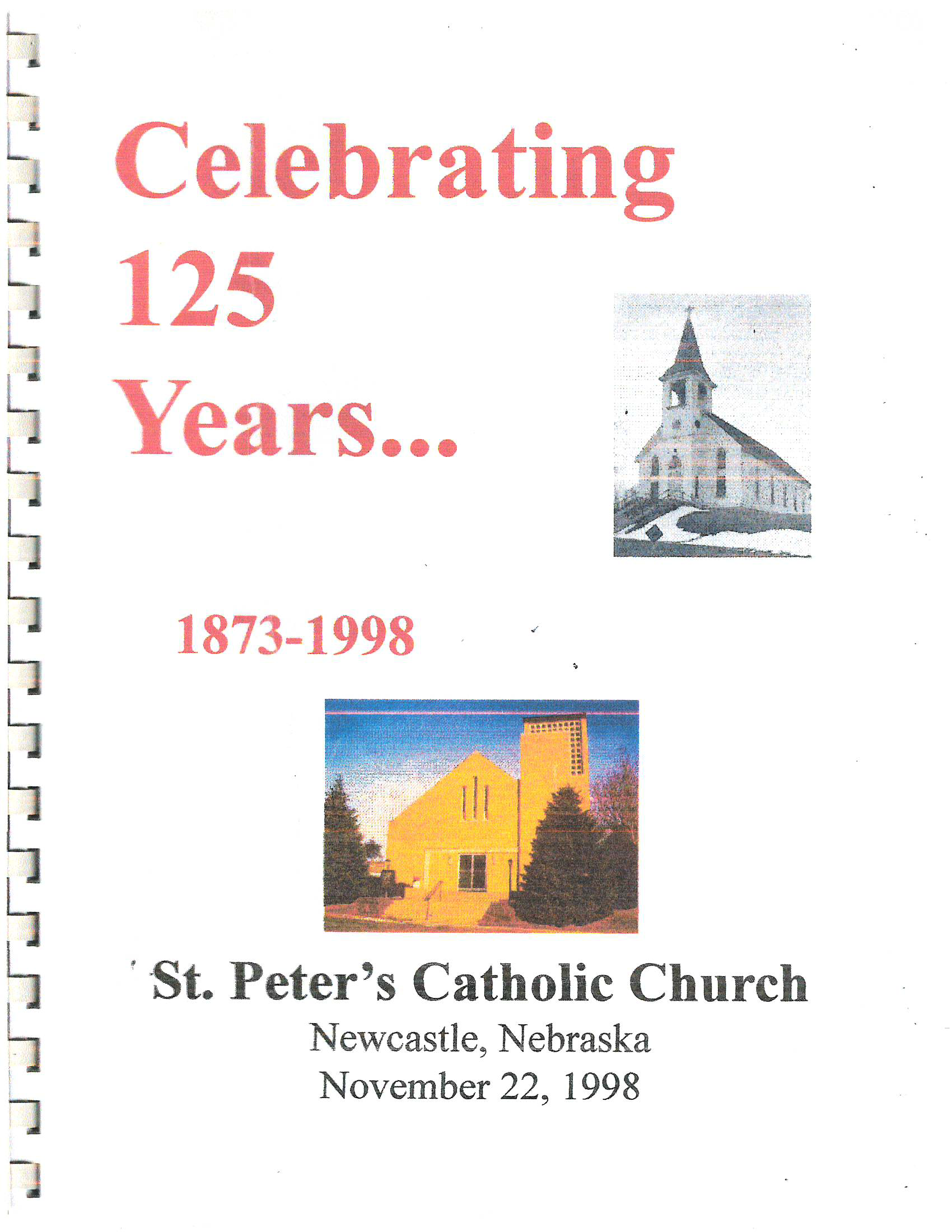
History excerpts from Celebrating 125 Years 1873-1998, St. Peter’s Catholic Church, Newcastle, Nebraska, p. iii-vi.
In the year 1873, a building 24 feet by 36 feet in dimension was built in the Village of Newcastle. The structure was known as St Peters Catholic Church. All the real estate around St Peters Church, namely 18 lots and a cemetery consisting of 2 acres, was the generous gift of Newcastle's founder, Gustavus (Schmidt) Smith. Mr. Smith was not a Catholic, but obviously was a good friend to the Catholic families in the Newcastle area. For several years the interior of the church was left unfinished. The church had a cottonwood floor and was without any paint or plaster. The alter consisted of a cottonwood board.
In the fall of 1877, Father O'Toole became the first resident Pastor in Newcastle. Father O'Toole was in charge of all of the Dixon County area as well as parts of Dakota and Cedar Counties. He finished the interior of the church and built his own residence. There were about forty families in the parish when he arrived.
Father O'Toole remained in Newcastle until 1892 when he was transferred to North Platte, Nebraska. The Reverend Michael P. Waldron filled-in as Pastor of St. Peter's Parish until 1996 when Father O'Toole returned to Newcastle upon his own request.

Fr. Michael O'Toole

St. Peter's second church, built in 1898.
By 1898, the number of parish families had grown to fifty. Under the leadership of Rev. O'Toole, a new church was built. It was a 40 by 97 foot structure costing $4,500 and was completely paid for when finished. A residence was built in 1901 at a cost of $2,711.
After 40 years of faithful service, Father O'Toole retired from active duty in 1919. The Women Foresters gave Father O'Toole a reception and banquet at St. Peter's Hall with 500 persons in attendance. Mr. Verzani presented Father O'Toole with a draft of $1,256 and the woman Foresters bestowed him a silk umbrella. All attended the Opera House for entertainment following the reception.
Replacing Rev. O'Toole was Rev. William Giblin who came to Newcastle in 1919 from St Mary's Parish in O'Neill. In 1920 St. Peter's began First Communion classes under the guidance of Father Giblin. The class received their First Communion on May 23, 1920 and consisted of 18 boys and 16 girls.
In 1927 Father Giblin was honored on his 10th anniversary as pastor in Newcastle with a dinner and program at St. Peter's Hall. The program consisted of Frank Krager as Master of Ceremonies, address by Mrs. A. Lubben, readings by Lucille Breslin, Frances Richards, Mrs. Leo Hoy, solos by Elaine Kent, Esther Bennett and Marie Hoy and a quartet featuring B. Koch, N. Kneift, and C. Conway.
Realizing the need for improvement of the present structure, Father Giblin began the arduous task of collecting funds for improving the old structure in 1945. After much deliberation, it was decided the cost of repairing the old church would be prohibitive and the parish decided to abandon the idea in favor of the erection of a new church.
Father Giblin began working on the plans to construct the new church. However, before the building was actually started he was transferred to St Agnes' Church in Omaha. The transfer ended 34 years of service as pastorate in Newcastle. A farewell celebration was held in Father Giblin's honor where he was presented with a gift of a car.
In June 1954, Msgr. Albert Krejci became the new pastor of St. Peter's parish after being transferred from Lyons. Nebraska. Msgr. Krejci continued the movement for a new church. Contributions for the new church totaled $30,000 in his first year despite a policy of no solicitation. After lots of hard work and planning with the trustees (Louis Reinertt and Peter Kneifl), contracts were signed to begin the new church on July 14, 1954.
To make room for the new church, the original 1873 church, which was being used as the Parish Hall, was moved to Newcastle's main street. It was located north of the current fire ħall where it was used as the town hall. (The altar area had been converted to a kitchen while the nave of the church was used as a hall). In 1972, the building was torn down after 100 years of use.
On May 4, 1955, The Most Reverend Gerald T Bergan, Archbishop officiated the pontifical blessing of the new church. The modern modified Gothic design church structure was designed by the Sioux City architectural firm of William Buettler. Stressing practicality, the structure features simple and modern lines. Overall length is 105 feet with a maximum width of 53 feet. The nave of the church is 40 feet wide by 73 feet long with a seating capacity of 320 persons. A choir loft that can accommodate 40 persons is located on the south end of the church. Glass doors feature the main entrance on the south. The large sanctuary is flanked by a priest's sacristy and a server's sacristy on either side. The basement facilitates rest rooms, a utility room and furnace room. In November 1957 the parish celebrated as the new church already became debt free.
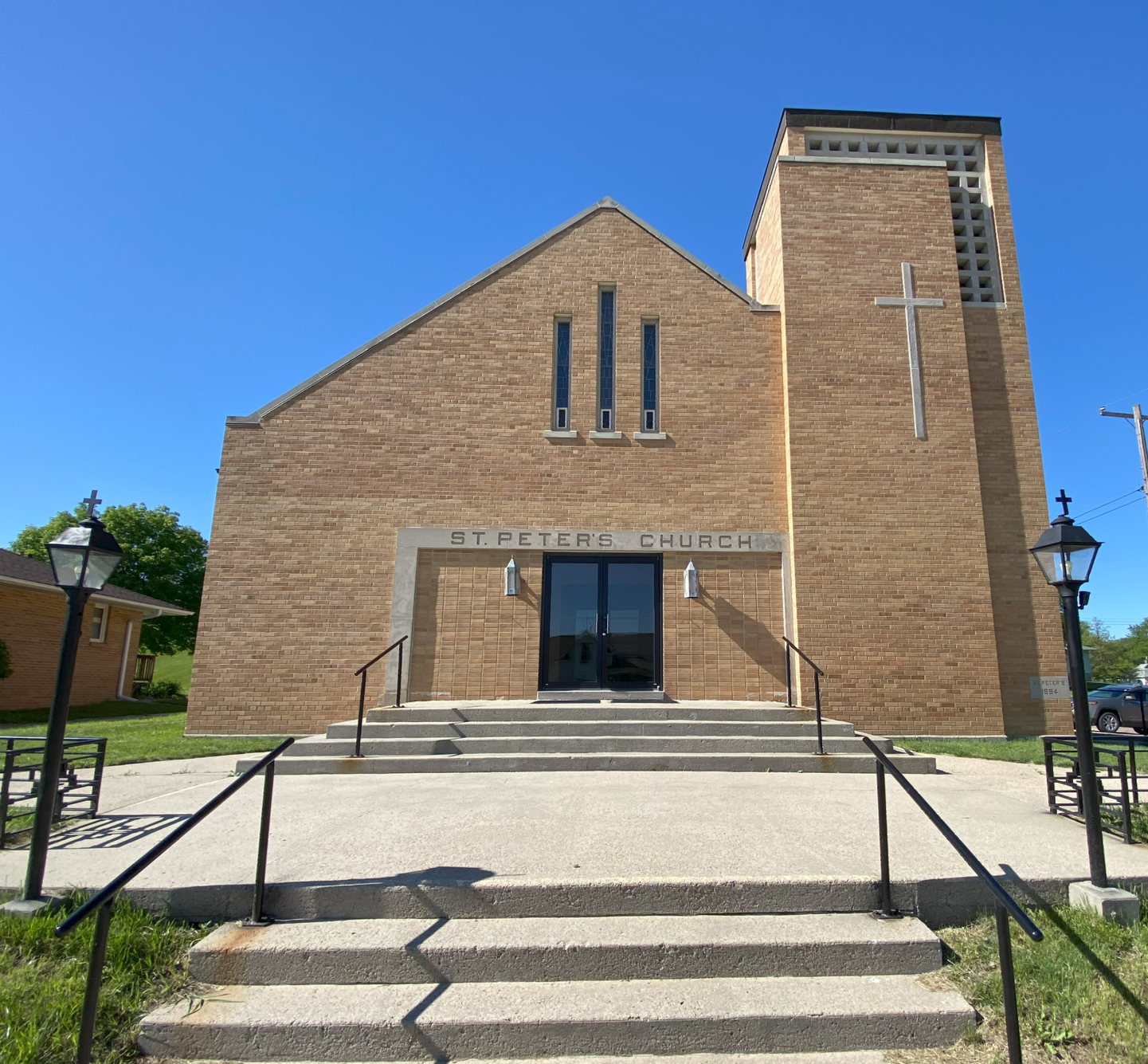
St. Peter current church.
A beautiful 3-bedroom, one story rectory with full basement was constructed in 1959. To make room for the rectory, St. Peter's second church building, which was being used as the parish hall, was torn down. Msgr. Krejci thus became the first person to live in the new rectory. He continued to serve the Newcastle parish until his transfer to Holy Agnes Church in Omaha on June 17, 1965.
In 1965, the Rev. Martin Conley became the fifth pastor to serve St. Peter's parish following tenures at St Cecilia's and St Bernard's in Omaha. During the winter of 1965-66 a change in the church mass, which would have the priest facing the parishioners, was fast approaching. Needing an altar, Father Conley asked Leonard Kneifl to build one for the church. Leonard was a good carpenter and felt privileged to be asked. The altar was the centerpiece of the sanctuary for many years.
Father Conley soon saw the need for a new hall for the many social functions of the parish and a place for catechetical classes. He began working on the project the following year. On June 15, 1969, The Most Rev. Gerald T Bergan, Archbishop of Omaha blessed and dedicated the 4,000 square foot St. Peter's Hall. The Archbishop complimented Father Conley for his work and good taste in the building of this nice ball. He also praised the people and thanked them for their cooperation during past years when these three brick buildings were erected.
Before the official dedication, the first CCD two-week summer school had already began on June 9. Classes were taught by School Sisters of St Francis. The sisters stayed in the rural home of Laurence and Amanda Kneifl.
On February 2, 1969, St. Patrick's Church at Tara Hill was destroyed by fire. Fourteen families from that parish joined St. Peter's, thus increasing the number of families in St. Peter's parish to 117. St. Peter's has since taken up the responsibility as caretaker of the Tara Hill Cemetery.
Listen to the history of St. Patrick, Tara Hill, as part of Fr. Vogel's Faith on the Frontier series.
Pastoral service during St. Peter's second century has greatly contrasted the first 100 years. After having just six priests in the first 100 years, St. Peters has already been served by 13 different pastors in the past 25 years, including a second tenure by Msgr. Krejci.
On June 15, 1972, Father Conley was transferred to St. Patrick's Parish in O'Neill. He was replaced by Msgr. Floyd Fischer, who was pastor of St Joseph's Parish in Platte Center, Nebraska. On June 6, 1973, St Peter's celebrated its 100 year anniversary with a mass officiated by Archbishop Daniel E Sheehan. Many former St. Peter's parishioners and pastors were in attendance at the ceremony.
Mass Reverend Gerald Millenkamp succeeded Msgr. Fischer on November 8, 1973. However, just one week after his arrival, tragedy touched St. Peter's Parish as Reverend Millenkamp was killed in a two vehicle collision eight miles south of Pender. His funeral services at St. Cecilia's Cathedral in Omaha was attended by many per- sons. A Mass kit was donated as a Memorial.
Father Anthony Tresnak was then appointed administrator of St. Peters until Father William Rucker was ap- pointed pastor of St. Peter's in 1974. After Father Rucker left St. Peter's in 1976, Rev. Daniel F Soltys was appointed as administrator until Rev. James V. Brown replaced him as a transition substitute in 1978.
After having six priests in six years, stability was once again restored at St. Peter's Parish as Msgr. Krejci returned to St. Peter's after a 13 year absence. Msgr. Krejci served at St. Peter's from 1978 until 1985 when he returned to Omaha. In June of 1981, a celebration was held in honor of Msgr. Krejci's 40th Anniversary.
Father James Kramper came to Newcastle in June, 1985. He would serve St. Peter's until 1990 when he was succeeded by Rev. Ralph A. Lammers who remained at Newcastle until 1991. Rev. Robert Irwin was then appointed administrator of St. Peter's until Father Frank Jindra came to Newcastle in 1992 and 1993. Father. Jindra was then succeeded by Rev. Rick Arkfeld who served at Newcastle from 1993 to 1996. It was during this time that St. Peter's officially began a yoke arrangement with St. Joseph's Parish in Ponca.
In anticipation of the arrival of Rev. James J. Bartak in 1996, the rectory received a complete remodeling as well as a new roof. Father Bartak is presently still serving St. Peter's Parish. Hopefully Father Bartak will remain with us for many years to come.
At this writing, there are 140 families in St. Peter's Parish. These parishioners continue to carry the pride of the physical appearance of our church. The church has gone through the exterior pintucking process, the stain glass windows have been coated and resealed, the pews were completely redone along with new songbook holders, and the communion rail was removed from the altar and implemented outdoors.
(Celebrating 125 Years 1873-1998, St. Peter’s Catholic Church, Newcastle, Nebraska, p. iii-vi)
Quick Links
Contact us
Office: 402-254-6559
Fax: 402-254-6553
email: holytrinity@hartel.net
406 South Broadway, PO Box 278
Hartington, NE 68739
